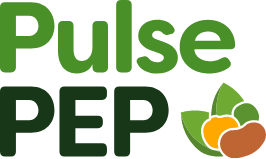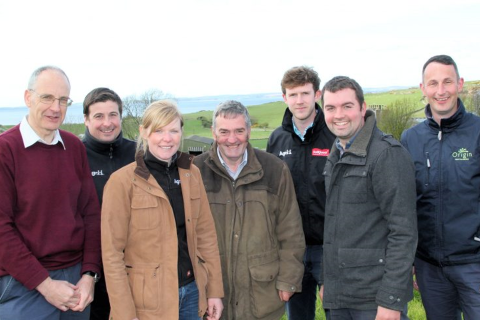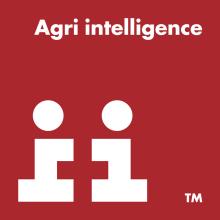Stranraer father and son, John and Robert Fleming, are challenging beef industry norms to increase output and reduce input costs in a ground-breaking iFarm project.
Working with Agrii agronomist, Lorna Galloway, the pair have transformed forage management at South Milton farm, where they run a 200-cow commercial beef business alongside their Stairhaven Aberdeen Angus pedigree herd.
This has been achieved over three years, through an Agrii iFarm project involving SoilQuest (now RHIZA), DLF Trifolium, Origin Fertilisers and Lancrop Laboratories.
Bigger savings and outputs
Beef production from grazed grass has been increased by a factor of more than five, through a combination of soil mapping and variable rate liming, sward renewal, specialist fertilisation and carefully managed paddock grazing.
Forage use on over-seeded pasture has been increased to rival the levels achieved by the best Irish dairy farms at almost 17t DM/ha.
This is producing just over 3,000kg/ha of beef at a net margin of over £6,000/ha.
At the same time, farm nitrogen use was reduced by a third last season, though greater liming precision, better quality swards, and more effective use of slurry.
The business also managed to save £30,000 in 2016 as a result of using no concentrates, which was achieved by extending the grazing season to 260 days and boosting home-grown protein with mixed arable silages and lucerne.
Further savings have been made with the young stock: More are on worm-free grazing, and grass palatability and trace elements have been improved, cutting anthelmintic and mineral supplement costs.
“We’ve been using a lot more lime than we did in the past to correct acidity problems that had crept up on us over the years,” explains Robert.
“Our electric fencing bill has shot up as well. But these extra costs are nothing against the productivity improvements and input savings we’ve been able to make as a result of our work with Agrii.
“Lorna and the iFarm team have opened our eyes to the potential we have to improve our productivity and reduce our risk by making more from home-grown forage in a host of innovative ways.
“With their help we’re transforming our whole production approach to make the very the most of the grazing abilities we’ve always concentrated upon in our Stairhaven breeding,” he says.
Precision agronomy input
Keen to make better use of their slurry after installing a separation system, and to boost output from home-grown forage, the Flemings turned to precision agronomy for their liming.
Using Agrii’s RHIZA service, they ran conductivity scanning across their 240ha, which mapped pH levels across the farm’s many soil types and showed levels ranging from 5.1 to 6.8.
“With hindsight, I suppose this wasn’t surprising,” says John. “Like many people, liming was something we did field-by-field every 8-10 years as we reseeded each in turn. And we limed on the basis of whole field pH measurements rather than sampling each soil zone individually as the RHIZA system does.
“Like many too, our slurry applications were always concentrated on the more accessible fields near the steading, so the acidity levels built-up far more rapidly here.
“Once we discovered this, we set about a major programme of liming with high availability Calcifert. Variable application according to the RHIZA management zones meant we only used what we strictly needed to bring all the ground up to at least pH 6.
“Since then, we’ve been topping-up with lime every year and applying our slurry far more evenly across the farm. This has made no end of difference.”
After this, South Milton’s forage improvement programme got into full gear in 2014/15, with a series of field trials as part of Agrii’s first-ever forage iFarm.
Over-seeding success
The farm saw a dramatic boost to grass productivity when the team over-seeded stocked land that hadn’t been touched for 35 years with high quality DLF grass and clover mixes.
Stock carrying capacity was more than doubled by rotationally grazing the rearing stock in 1ha paddocks with regular measurements of cover. This delivered exceptional levels of output over a much longer grazing season.
“We took full advantage of the excellent 2016 grass growing conditions by measuring the sward cover weekly and using a combination of grazing and silaging to stay ahead of it,” says Robert.
“So, unlike the past, we never had to top it once. What’s more, we were able to keep the quality of the sward high throughout the season and maintain very healthy clover contents. Lower faecal egg counts also meant we used less anthelmintics than normal.
“This experience has led us to move our entire system to paddock grazing – hence the increase in the electric fencing bill. We’re producing so much more grass now that we’re finishing most of our stock instead of selling the bulk as stores.
“We also running 130 extra young stock on performance-based contracts with neighbours this season on separate land we used to need for our own herd.”
Home-grown protein boost
Further iFarm trials explored boosting protein content of wholecrop cereal silage to provide extra winter fodder and a productive crop under which to establish new grass leys.
Of the six mixtures trialled in the first year, spring barley and peas proved the most productive, yielding 7.4t DM/ha at 13% protein, for a cost of 17p/kg of protein. The following year spring barley and yellow lupins took top spot with 9.2t DM/ha at 12% protein, for a cost of 15p/kg.
In both cases the Scotmaster long-term ley mixes sown under the crops came through well and took off like a rocket with the extra nitrogen supply from the legumes. This was then ready to graze almost immediately after harvest in late August.
Equally successful was the farm’s first attempt at growing lucerne. The field sown in April 2016 established well with remarkably few weeds to yield a total of 4.4t DM/ha at 17% protein in its initial, low production year.
On this basis, the team calculate that together with the arable silage, the 4ha they plan to grow each year should provide a 15% protein ration for 200 stores over 100 days.
“Home-produced protein is giving the business a valuable extra string to its beef production bow,” says Lorna. “The arable silage is proving just what we need. And, although it’s early days yet, the lucerne looks to have excellent potential.”
Enhanced fertiliser value
“We’re also seeing a really encouraging response to our use of specialist fertilisers to improve grazed grass productivity, palatability and mineral contents,” says Lorna.
“There’s lots of evidence that including sodium with grassland fertiliser increases the sugar content, intake and digestibility of grazed grass,” she says.
“We don’t yet have detailed data to confirm its value at South Milton, but last year the cattle showed a clear and consistent preference for the half of the field we fertilised with Origin Sweet-Grass, rather than the half receiving the same amount of nitrogen and sulphur without added sodium.
“Having the Sweet-Grass enhanced with cobalt and selenium to counter the low contents we always see in our soil, forage, and blood testing analysis, has further boosted the levels of both minerals in our silage by 75% or more,” she says.
This has meant John and Robert didn't to use any boluses, drenches or lick tubs for their youngstock last season.
“It’s all about making the forage work harder in every way we can,” continues Lorna. “That’s why we’re also looking at using polysuphate as a source of phased-release sulphur and to provide extra potash, calcium and magnesium.
“It’s also why we’re employing RHIZA, to ensure we use the right types of lime for the most productive ratios of calcium and magnesium across our ground.”
Thriving in an uncertain future
“More and better forage production and utilisation is driving everything we do now,” says Robert. “With the iFarm team’s help, we’re seeing so many new opportunities to up our game by growing forages with as much precision as any arable crop, and converting every bit we grow into quality beef.
“We’ve already been able to double our output without taking on any more land and plan to be producing 3,000kg of beef from at least 200 of our 240ha within the next five years.
“With our Angus genetics, this will leave us as well-placed as possible to thrive in whatever world we find ourselves after 2020. We’re really excited about what the future holds.”




